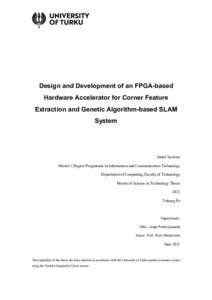Design and Development of an FPGA-based Hardware Accelerator for Corner Feature Extraction and Genetic Algorithm-based SLAM System
Fu, Yuhong (2021-07-28)
Design and Development of an FPGA-based Hardware Accelerator for Corner Feature Extraction and Genetic Algorithm-based SLAM System
Fu, Yuhong
(28.07.2021)
Julkaisu on tekijänoikeussäännösten alainen. Teosta voi lukea ja tulostaa henkilökohtaista käyttöä varten. Käyttö kaupallisiin tarkoituksiin on kielletty.
avoin
Julkaisun pysyvä osoite on:
https://urn.fi/URN:NBN:fi-fe2021082443972
https://urn.fi/URN:NBN:fi-fe2021082443972
Tiivistelmä
Simultaneous Localization and Mapping (SLAM) systems are crucial parts of mobile robots. These systems require a large number of computing units, have significant real-time requirements and are also a vital factor which can determine the stability, operability and power consumption of robots.
This thesis aims to improve the calculation speed of a lidar-based SLAM system in domestic scenes, reduce the power consumption of the SLAM algorithm, and reduce the overall cost of the whole platform. Lightweight, low-power and parallel optimization of SLAM algorithms are researched. In the thesis, two SLAM systems are designed and developed with a focus on
energy-efficient and fast hardware-level design: a geometric method based on corner extraction and a genetic algorithm-based approach. Finally, an FPGA-based hardware accelerated SLAM is implemented and realized, and compared to a software-based system.
As for the front-end SLAM system, a method of using a Corner Feature Extraction (CFE) algorithm on FPGA platforms is first proposed to improve the speed of the feature extraction. Considering building a back-end SLAM system with low power consumption, a SLAM system based on genetic algorithm combined with algorithms such as Extended Kalman Filter (EKF)
and FastSLAM to reduce the amount of calculation in the SLAM system is also proposed. Finally, the thesis also proposes and implements an adaptive feature map which can replace a grid point map to reduce the amount of calculation and utilization of hardware resources.
In this thesis, the lidar SLAM system with front-end and back-end parts mentioned above is implemented on the Xilinx PYNQ Z2 Platform. The implementation is operated on a mobile robot prototype and evaluated in real scenes. Compared with the implementation on the Raspberry Pi 3B+, the implementation in this thesis can save 86.25% of power consumption. The lidar SLAM system only takes 20 ms for location calculation in each scan which is 5.31 times faster compared with the software implementation with EKF.
This thesis aims to improve the calculation speed of a lidar-based SLAM system in domestic scenes, reduce the power consumption of the SLAM algorithm, and reduce the overall cost of the whole platform. Lightweight, low-power and parallel optimization of SLAM algorithms are researched. In the thesis, two SLAM systems are designed and developed with a focus on
energy-efficient and fast hardware-level design: a geometric method based on corner extraction and a genetic algorithm-based approach. Finally, an FPGA-based hardware accelerated SLAM is implemented and realized, and compared to a software-based system.
As for the front-end SLAM system, a method of using a Corner Feature Extraction (CFE) algorithm on FPGA platforms is first proposed to improve the speed of the feature extraction. Considering building a back-end SLAM system with low power consumption, a SLAM system based on genetic algorithm combined with algorithms such as Extended Kalman Filter (EKF)
and FastSLAM to reduce the amount of calculation in the SLAM system is also proposed. Finally, the thesis also proposes and implements an adaptive feature map which can replace a grid point map to reduce the amount of calculation and utilization of hardware resources.
In this thesis, the lidar SLAM system with front-end and back-end parts mentioned above is implemented on the Xilinx PYNQ Z2 Platform. The implementation is operated on a mobile robot prototype and evaluated in real scenes. Compared with the implementation on the Raspberry Pi 3B+, the implementation in this thesis can save 86.25% of power consumption. The lidar SLAM system only takes 20 ms for location calculation in each scan which is 5.31 times faster compared with the software implementation with EKF.
